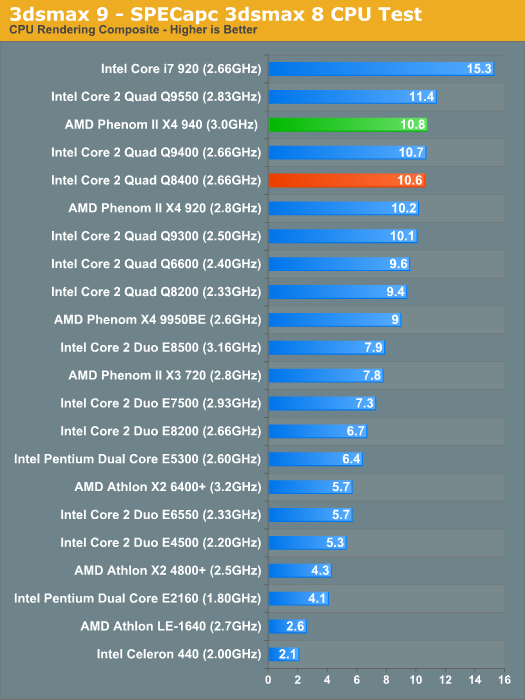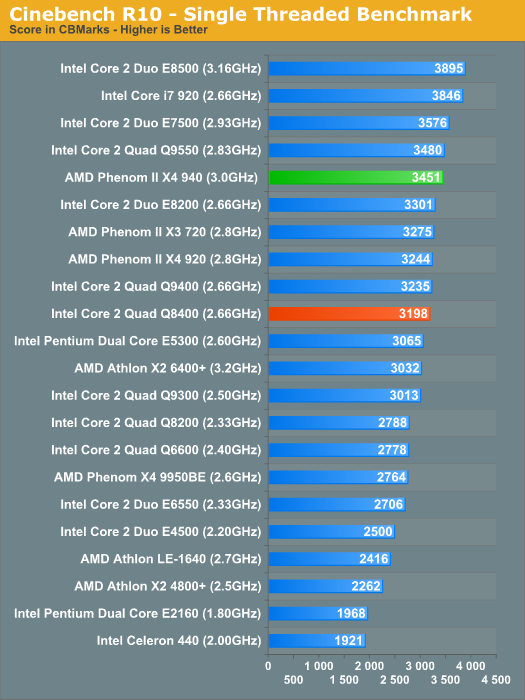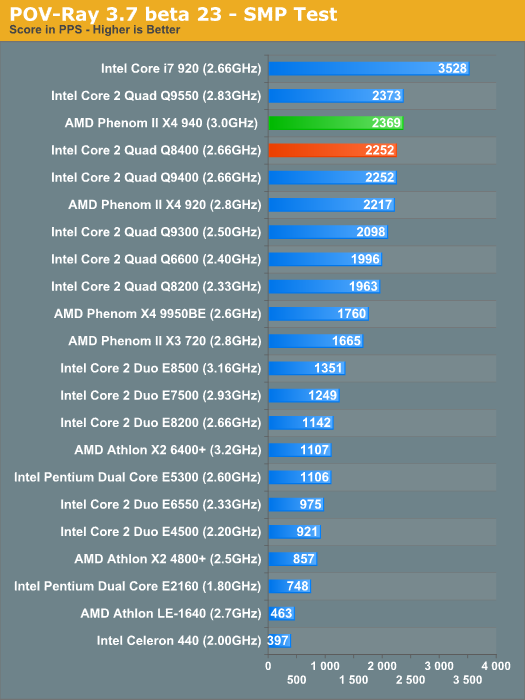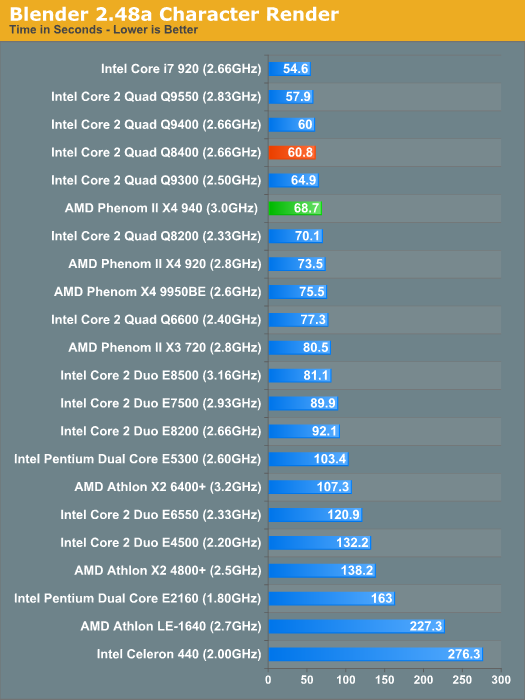The Core 2 Quad Q8400: Intel's $183 Phenom II 940 Competitor
by Anand Lal Shimpi on May 7, 2009 12:00 AM EST- Posted in
- CPUs
3dsmax 9 - SPECapc 3dsmax CPU Rendering Test
Today's desktop processors are more than fast enough to do professional level 3D rendering at home. To look at performance under 3dsmax we ran the SPECapc 3dsmax 8 benchmark (only the CPU rendering tests) under 3dsmax 9 SP1. The results reported are the rendering composite scores:

Once more we have a situation where the Q8400 and Phenom II 940 are similar in performance, with AMD holding onto a negligible 2% advantage.
Cinebench R10
Created by the Cinema 4D folks we have Cinebench, a popular 3D rendering benchmark that gives us both single and multi-threaded 3D rendering results.

There's no questioning the Cinebench results, this is one of those areas where the Phenom II is just plain faster than the Q8400. The lead here is around 7%.

POV-Ray 3.73 beta 23 Ray Tracing Performance
POV-Ray is a popular, open-source raytracing application that also doubles as a great tool to measure CPU floating point performance.
I ran the SMP benchmark in beta 23 of POV-Ray 3.73. The numbers reported are the final score in pixels per second.

The trend continues in POV-ray, the Phenom II 940 holds onto a 5% performance advantage over the Q8400 here.
Blender 2.48a
Blender is an open source 3D modeling application. Our benchmark here simply times how long it takes to render a character that comes with the application.

The more your application is optimized for Intel's architecture however, the faster the tables can turn. Performance in Blender is dominated by the Q8400.










60 Comments
View All Comments
erple2 - Saturday, May 9, 2009 - link
while there may be fewer defects per wafer, there are also fewer chips per wafer (about 57% fewer). To take the analogy to the extreme, lets say that AMD makes one chip that consumes the entire wafer, and Intel can make 2. If there is, on average, 1 defect per wafer for AMD and 5 defects per wafer for Intel, AMD has zero good chips per wafer, and Intel has (on average), 2 good chips per 5 wafers. That example is horribly contrived, sure, but I used it to show that even having a better process (fewer defects per wafer) doesn't guarantee a good result if the size of the chunks you use on the wafer is significantly larger - AMD's can fit quite a few less per wafer (about half?).erple2 - Saturday, May 9, 2009 - link
arg... edit button... Intel would have 1 good chip per 3 wafers. I assumed 4 defects per wafer, not 5 in the 2/5 ...slayerized - Thursday, May 7, 2009 - link
You are confusing yield and throughput - they are two different things.8steve8 - Thursday, May 7, 2009 - link
no Virtualization Tech... so no windows 7 virtual PC, no hyper-v...that sucks.
rather go phenom 2, intel e8xxx or q9xxx
ltcommanderdata - Friday, May 8, 2009 - link
I don't think the lack of VT will be a huge issue for the average consumer. The Q8400 is a budget quad core and OEMs will no doubt be bundling Windows 7 Home Premium with it which doesn't support XP Mode anyways. Tech savy buyers who build their own computers with a Q8400 and Professional Edition would notice, but the larger impediment to XP Mode adoption is probably still Microsoft's production edition matrix.Anand Lal Shimpi - Thursday, May 7, 2009 - link
Very good point, I've updated the conclusion to point out the difference. Honestly it's ridiculous that Intel isn't enabling it on these chips.Take care,
Anand
spazmedia - Thursday, May 7, 2009 - link
I second this. Just bought a intel box with an E5200 thinking it had VT. Hopefully they will follow AMD's lead.GeorgeH - Thursday, May 7, 2009 - link
+1No support for Windows 7 XP Mode is the reason I chose AMD over an Intel Q8X00 in the PC I just built.
leomax999 - Thursday, May 7, 2009 - link
Intel has announced vt support for Q8300, E7400, E7500, E5300, E5400.So i dont see any reason why q8400 shouldnt get it.
http://www.tcmagazine.com/comments.php?shownews=25...">http://www.tcmagazine.com/comments.php?shownews=25...
GeorgeH - Thursday, May 7, 2009 - link
Thanks for the link, but to be clear the chips you listed will never support VT.Intel is supposed to be releasing Q8300".1", E7400".1", etc. chips, but unless they change the model number I can only see that leading to mass confusion. Forcing average people to check the S-Spec or MM number against a list to see what they're actually getting is a classic recipe for fail.
Until those updated Intel chips hit the market, AMD will remain the only real choice for budget and midrange quad core.